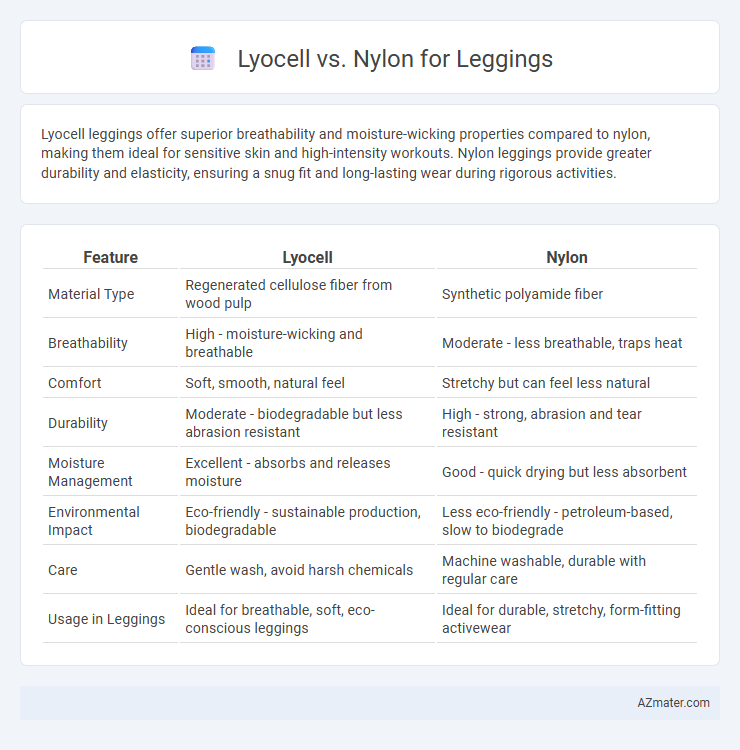Lyocell leggings offer superior breathability and moisture-wicking properties compared to nylon, making them ideal for sensitive skin and high-intensity workouts. Nylon leggings provide greater durability and elasticity, ensuring a snug fit and long-lasting wear during rigorous activities.
Table of Comparison
| Feature | Lyocell | Nylon |
|---|---|---|
| Material Type | Regenerated cellulose fiber from wood pulp | Synthetic polyamide fiber |
| Breathability | High - moisture-wicking and breathable | Moderate - less breathable, traps heat |
| Comfort | Soft, smooth, natural feel | Stretchy but can feel less natural |
| Durability | Moderate - biodegradable but less abrasion resistant | High - strong, abrasion and tear resistant |
| Moisture Management | Excellent - absorbs and releases moisture | Good - quick drying but less absorbent |
| Environmental Impact | Eco-friendly - sustainable production, biodegradable | Less eco-friendly - petroleum-based, slow to biodegrade |
| Care | Gentle wash, avoid harsh chemicals | Machine washable, durable with regular care |
| Usage in Leggings | Ideal for breathable, soft, eco-conscious leggings | Ideal for durable, stretchy, form-fitting activewear |
Introduction to Lyocell and Nylon
Lyocell, a sustainable fabric made from wood pulp, offers exceptional breathability and moisture-wicking properties, making it ideal for comfortable leggings. Nylon, a synthetic polymer, is highly durable and elastic, providing excellent stretch and shape retention for activewear. Both fabrics serve distinct purposes, with Lyocell emphasizing eco-friendly comfort and Nylon delivering strength and flexibility.
Material Overview: Lyocell vs Nylon
Lyocell is a sustainable, biodegradable fiber derived from wood pulp, known for its breathability, moisture-wicking properties, and softness, making it ideal for leggings that prioritize comfort and eco-friendliness. Nylon, a synthetic polymer, offers exceptional durability, elasticity, and abrasion resistance, providing excellent shape retention and support in activewear leggings. While Lyocell excels in natural comfort and environmental benefits, nylon outperforms in resilience and stretch, influencing legging performance and user experience.
Environmental Impact Comparison
Lyocell leggings offer a significantly lower environmental impact compared to nylon, as Lyocell is made from sustainably sourced wood pulp using a closed-loop production process that recycles solvents and minimizes waste. Nylon, derived from petrochemicals, involves energy-intensive manufacturing and releases nitrous oxide, a potent greenhouse gas, contributing to higher carbon emissions. Choosing Lyocell reduces resource depletion and pollution, making it a more eco-friendly option for sustainable activewear production.
Comfort and Feel: Which is Softer?
Lyocell leggings offer superior softness due to their natural cellulose fibers that provide a smooth, breathable, and moisture-wicking feel against the skin. Nylon leggings, while durable and stretchy, tend to have a slightly slicker texture that may feel less soft and more synthetic. For comfort and a gentle touch, Lyocell is often preferred over nylon, especially for sensitive skin and all-day wear.
Breathability and Moisture Management
Lyocell leggings excel in breathability and moisture management due to their natural cellulose fibers that absorb moisture efficiently and promote airflow, keeping the skin dry and comfortable during workouts. Nylon leggings, while durable and quick-drying, tend to trap heat and moisture, which can lead to reduced breathability and a less comfortable experience during intense physical activity. Choosing Lyocell for leggings enhances ventilation and moisture-wicking properties, making it ideal for users prioritizing comfort and temperature regulation.
Durability and Longevity
Lyocell leggings offer moderate durability with natural fiber properties that resist pilling and maintain softness over time, making them ideal for everyday wear. Nylon leggings excel in durability and longevity due to their synthetic composition, providing superior resistance to abrasion, stretching, and washing, which ensures they maintain shape and performance during intense physical activities. Choosing nylon guarantees longer-lasting leggings for high-impact workouts, while lyocell provides a comfortable, eco-friendly option with sufficient durability for casual use.
Stretch and Flexibility in Leggings
Lyocell fabric offers excellent stretch and flexibility for leggings due to its natural fiber structure and moisture-wicking properties, providing breathable comfort and a smooth fit. Nylon leggings excel in stretch retention and durability, often incorporating elastane for superior elasticity that maintains shape during intense activities. For activewear requiring both flexibility and long-lasting stretch, nylon blends outperform Lyocell, though Lyocell provides a softer, more breathable alternative for everyday wear.
Care and Maintenance Requirements
Lyocell leggings require gentle washing with mild detergent and air drying to maintain their softness and prevent shrinkage, while nylon leggings are more durable, often allowing machine washing and quick drying without significant damage. Lyocell fibers are more prone to weakening when exposed to harsh chemicals or high heat, making cold water washes essential. Nylon leggings tolerate higher temperatures and resist stretching, but excessive heat from dryers can degrade elasticity over time.
Price Difference: Lyocell vs Nylon Leggings
Lyocell leggings typically cost more than nylon leggings due to the sustainable, eco-friendly production process and the use of natural wood pulp fibers in Lyocell fabric. Nylon leggings are generally more affordable because nylon is a synthetic fiber produced at a larger scale with lower material and manufacturing costs. The price difference reflects factors like durability, moisture-wicking properties, and environmental impact, making Lyocell a premium option compared to budget-friendly nylon leggings.
Final Verdict: Which Legging Material is Better?
Lyocell leggings offer superior breathability, moisture-wicking properties, and natural biodegradability, making them ideal for eco-conscious consumers seeking comfort and sustainability. Nylon leggings provide excellent durability, stretch retention, and resistance to abrasion, favored for high-performance activities and long-lasting wear. The final verdict depends on user priorities: choose Lyocell for sustainability and softness or Nylon for durability and athletic performance.

Infographic: Lyocell vs Nylon for Legging
 azmater.com
azmater.com